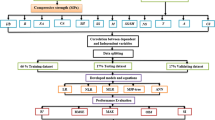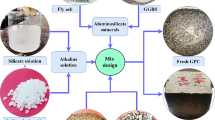Abstract
Among the recent discoveries for alternatives of portland cement (PC) concrete, Alkali-activated binder (AAB) concrete is prolifically being considered as the most eco-friendly and sustainable alternative. The present study evaluates the shrinkage behaviour for three different AAB mixtures containing fly ash and/or slag at different proportions which are activated by sodium hydroxide and sodium silicate. Multiple linear regression models are developed to predict shrinkage strains of ambient-cured AAB concrete as a function of age and percentage of fly ash in the precursor. The aim of this work is to come up with a generalized equation that can predict the shrinkage of various binary blended AAB mixes cured at room temperature. The predicted models are ranked based on RMSE and then compared with the experimental data. The correlations were found to be quite satisfactory (R2 = 0.937) and can be used to estimate the shrinkage for similar AAB mixtures. It is observed that the proposed model agrees more closely with the experimental results from the present study.
Access this chapter
Tax calculation will be finalised at checkout
Purchases are for personal use only
Similar content being viewed by others
References
Deb PS, Nath P, Sarker PK (2014) The effects of ground granulated blast-furnace slag blending with fly ash and activator content on the workability and strength properties of geopolymer concrete cured at ambient temperature. Mater Des 62:32–39
Jia Z, Yang Y, Yang L, Zhang Y, Sun Z (2018) Hydration products, internal relative humidity and drying shrinkage of alkali activated slag mortar with expansion agents. Constr Build Mater 158:198–207
Lee NK, Lee HK (2013) Setting and mechanical properties of alkali-activated fly ash/slag concrete manufactured at room temperature. Constr Build Mater 47:1201–1209
Ma Y, Ye G (2015) The shrinkage of alkali activated fly ash. Cem Concr Res 68:75–82
Nath P, Sarker PK (2014) Effect of GGBFS on setting, workability and early strength properties of fly ash geopolymer concrete cured in ambient condition. Constr Build Mater 66:163–171
Thomas JJ, Allena J, Jennings HM (2012) Density and water content of nano-scale solid C-S-H formed in alkali-activated slag (AAS) paste and implications for chemical shrinkage. Cem Concr Res 42(2):377–383
Castel A, Foster SJ, Ng T, Sanjayan JG, Gilbert RI (2016) Creep and drying shrinkage of a blended slag and low calcium fly ash geopolymer Concrete. Mater Struct 49(5):1619–1628
Gilbert RI (2002) Creep and shrinkage models for high strength concrete–proposals for inclusion in AS3600. Aust J Struct Eng 4(2):95–106
Rashad AM (2013) Properties of alkali-activated fly ash concrete blended with slag. Iran J Mater Sci Eng 10(1):57–64
Wallah S, Rangan BV (2006) Low-calcium fly ash-based geopolymer concrete: long-term properties, Research Report GC 2, Faculty of Engineering, Curtin University of Technology, Perth, Australia
Ye H, Radlińska A (2016) Shrinkage mechanisms of alkali-activated slag. Cem Concr Res 88:126–135
Fang G, Bahrami H, Zhang M (2018) Mechanisms of autogenous shrinkage of alkali-activated fly ash-slag pastes cured at ambient temperature within 24 h. Constr Build Mater 171:377–387
Gao X, Yu QL, Brouwers HJH (2015) Reaction kinetics, gel character and strength of ambient temperature cured alkali activated slag–fly ash blends. Constr Build Mater 80:105–115
American Society for Testing and Materials International, ASTM C618-17a (2017) Standard Specification for Coal Fly Ash and Raw or Calcined Natural Pozzolan for Use in Concrete, West Conshohocken, PA
American Society for Testing and Materials International, ASTM C989/C989M-17 (2017) Standard Specification for Slag Cement for Use in Concrete and Mortars, ASTM International, West Conshohocken, PA
American Society for Testing and Materials International, ASTM C33/C33M–16e1 (2016) Standard Specification for Concrete Aggregates, West Conshohocken, PA
American Society for Testing and Materials International, ASTM C494/C494M-17 (2017) Standard Specification for Chemical Admixtures for Concrete, West Conshohocken, PA
American Society for Testing and Materials International, ASTM C157/C157M-17 (2017) Standard Test Method for Length Change of Hardened Hydraulic-Cement Mortar and Concrete, West Conshohocken, PA
Thomas RJ, Peethamparan S (2017) Stepwise regression modeling for compressive strength of alkali-activated concrete. Constr Build Mater 141:315–324
Author information
Authors and Affiliations
Corresponding author
Editor information
Editors and Affiliations
Rights and permissions
Copyright information
© 2020 Springer Nature Switzerland AG
About this paper
Cite this paper
Boindala, S.P., Ramagiri, K.K., Alex, A., Kar, A. (2020). Step-Wise Multiple Linear Regression Model Development for Shrinkage Strain Prediction of Alkali Activated Binder Concrete. In: Dasgupta, K., Sajith, A., Unni Kartha, G., Joseph, A., Kavitha, P., Praseeda, K. (eds) Proceedings of SECON'19. SECON 2019. Lecture Notes in Civil Engineering, vol 46. Springer, Cham. https://doi.org/10.1007/978-3-030-26365-2_9
Download citation
DOI: https://doi.org/10.1007/978-3-030-26365-2_9
Published:
Publisher Name: Springer, Cham
Print ISBN: 978-3-030-26364-5
Online ISBN: 978-3-030-26365-2
eBook Packages: EngineeringEngineering (R0)




